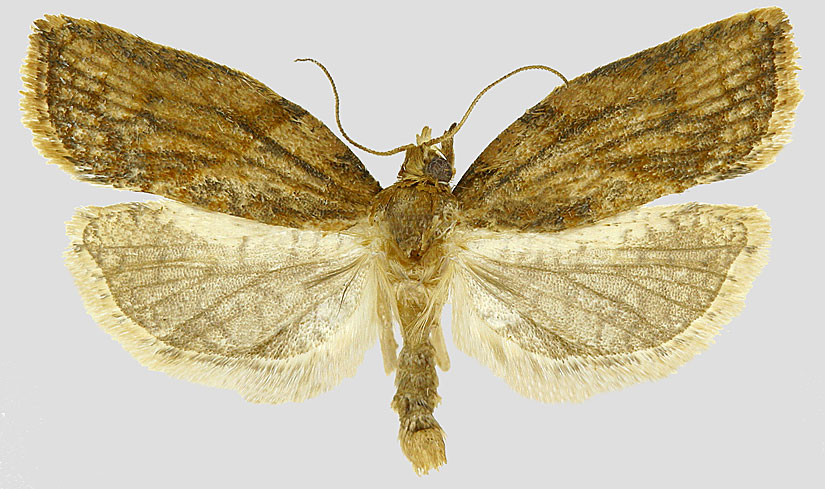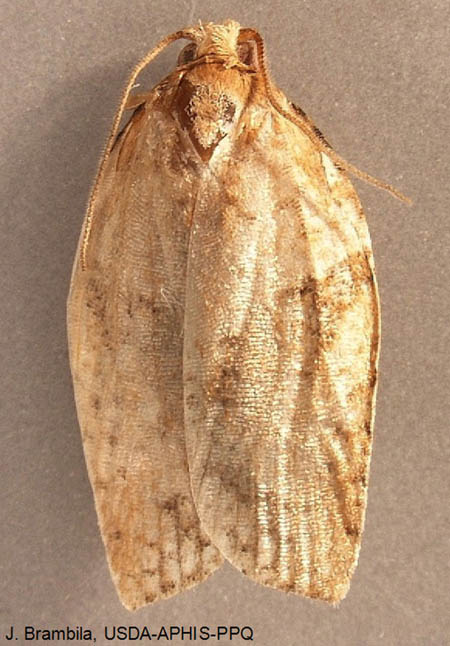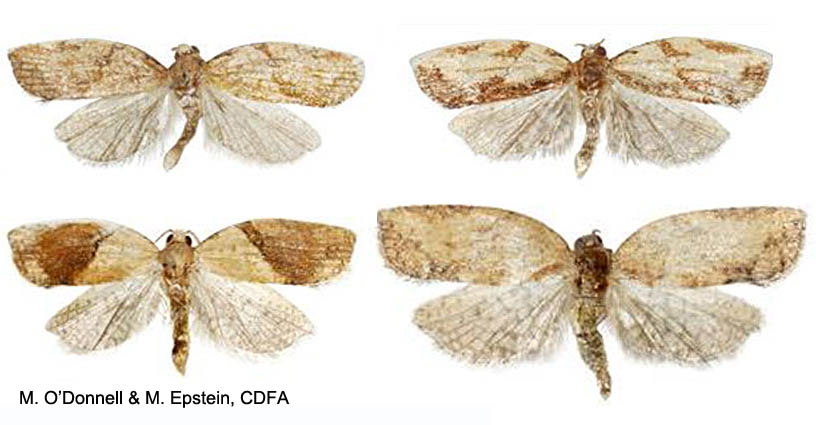Special Feature
The Regulatory Corner: Light Brown Apple Moth Not To Be Taken Lightly [pdf]
Harry Fulton
State Entomologist, Mississippi Department of Agriculture and Commerce, Bureau of Plant Industry, Mississippi State, MS 39760.
Received 3-VI-2008
Speaking of regulatory corners, it seems that we are always backed into a corner by some pest that we regulators can not corner with current regulatory tools and levels of funding. Quarantines have a place, but they are becoming harder to enforce and in the last issue I explained a few reasons.
One such pest now under quarantine and eradication efforts in California is the light brown apple moth (LBAM), Epiphyas postvittana (Walker). For this issue I want to update readers on this quarantine activity and concerns about LBAM.
Potential Damage
The following summarizes a section on potential damage in an article entitled, “Light Brown Apple Moth’s Arrival in California Worries Commodity Groups.”
Like other tortricid leafrollers, light brown apple moth feeds from and houses itself within a sheltering nest of rolled leaves it constructs. Damage to foliage is usually not considered a major problem in fruit crops; however it can be of economic importance on nursery stock and of cosmetic importance on landscape ornamentals. The primary concern on fruit crops is damage to fruit, whereby young larvae enter the interior of pome fruits through the calyx and cause internal damage to stone fruits. Later, larvae may consume the outermost layers of the fruit surface. Also, minor feeding damage can take the form of pinpricks, or “stings,” on the fruit surface. In grapes, larvae can cause extensive loss of flowers or newly set berries in the spring. Later in the season, grapes can be severely damaged by larvae feeding among the berries, allowing plant pathogens to enter and cause mold. In citrus, larval feeding causes fruit drop or halo scars around the stem end of the fruit. In crops such as kiwifruit, plum, citrus and pome fruit, the maturing fruit produces a layer of corky tissue over the leafroller damage. Buds of deciduous host plants are vulnerable to attack in the winter and early spring. Conifers are damaged by larval activities such as needle tying, chewing of buds and boring into stems. In tree nurseries, damage to terminal buds on seedlings and saplings can cause multiple or crooked leaders.
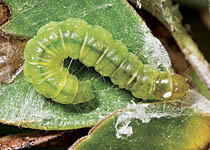
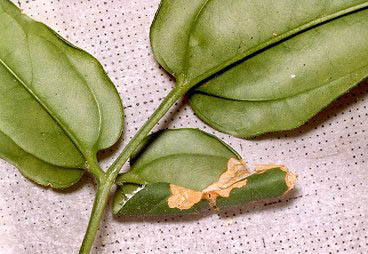
To put things in perspective for the southern states, Dr. Richard Brown, Professor and Taxonomist at Mississippi State University who serves on the LBAM Technical Committee, says that "What sets LBAM apart from other exotic pests is its very wide host range. If this species becomes established in Mississippi, it will have the capability of becoming a pest of most fruits, including blueberries, peaches and grapes, many vegetables, roses, azaleas, and other garden and landscaping plants. This species of moth is unusual in that its caterpillar will also feed on pine and cypress. We don't know if it will feed on soybean, but this is highly possible because it is known to feed on other kinds of legumes."
Background
The information in this section is adapted from: http://www.aphis.usda.gov/plant_health/plant_pest_info/lba_moth/index.shtml
The light brown apple moth (LBAM), Epiphyas postvittana (Tortricidae), is a native pest of Australia and is now widely distributed in New Zealand, the United Kingdom, Ireland, and New Caledonia. Although it was reported in Hawaii in the late 1800s, a recent LBAM detection in California is the first on the United States mainland. USDA confirmed the detection of LBAM in Alameda County, California on March 22, 2007. The California Department of Food and Agriculture (CDFA) aggressively surveyed the area to discover the extent to the infestation and identified the pest in 11 additional counties. Intense control activities have contained LBAM within the initial detection area, and effectively eradicated the pest from Napa and Los Angeles counties.
LBAM is of particular concern because it can damage a wide range of crops and other plants including California’s prized cypress as well as redwoods, oaks and many other varieties commonly found in California’s urban and suburban landscaping, public parks and natural environment. The list of agricultural crops that could be damaged by this pest includes grapes, citrus, stone fruit (peaches, plums, nectarines, cherries, apricots) and many others. The complete “host list” contains well over 1,000 plant species and more than 250 fruits and vegetables.
Biology
The adult insect is a moth about 10 mm long when esting with the wings folded in a characteristic bell shape. Coloring is variable but they are generally yellowish-brown with darker brown markings on the forewings. The females often have a dark spot on the hind margin of the forewing. Females can lay eggs between six and 10 days after moth emergence, depending on the temperature. Eggs are laid in masses on the upper surface of any smooth-leaved host plants. The eggs are flat, and with a pebbled surface and take from five to more than 30 days to hatch, depending on the temperature.
The newly hatched larvae (caterpillars) are very tiny, with a pale yellow-green body and a pale brown head. Early instar larvae wander actively over plant surfaces and may suspend themselves from a fine silken thread until they find a suitable feeding site. The young larvae prefer the underside of leaves and usually start to feed adjacent to a vein where they spin a protective cover of fine webbing. The pupa (chrysalis) is at first green, but soon becomes brown after rapidly hardening, and then darkens during development. The pupa is typically found in a thin-walled silken cocoon between two leaves webbed together, and is usually 10-15 mm long; the female pupae are larger than those of the male. Males and females can be distinguished by examining the pupa from the lower surface.
Identification of LBAM
There are many native tortricids that can be confused for the LBAM. Adult moths must be identified by a qualified entomologist. Larval stages cannot be reliably identified by using morphological characters. Dr. Richard Brown at Mississippi State University is the official identifier for several states in the Midsouth and he will be responsible for checking submitted traps containing suspect moths. If someone suspects the presence of LBAM, please notify your state department of agriculture or your State Plant Health Director with USDA, APHIS, PPQ.
Quarantine in effect
A federal order or emergency quarantine imposing restrictions on interstate movement of regulated articles is currently in affect for the State of California (the counties of Alameda, Contra Costa, Marin, Monterey, San Francisco, San Mateo, Santa Clara, Santa Cruz, and Solano) and the State of Hawaii (all counties).
Economic data, situation reports and much more information are available on the APHIS Website, which include the latest information on eradication and delimiting surveys in California. The latest situation report reports that 40 counties are being delimited; almost 47,000 traps are being run bi-weekly, immature stages of the pest have been found in 64 nurseries, and a total of 23,779 moths have been identified to date.
National surveys planned for many states
Mid-southern and southeastern states are considered high risk states for LBAM; therefore, they are on the priority list to be surveyed. Each high priority state’s pest regulatory official will receive up to 350 pheromone traps to operate, depending on availability of personnel within the states to do the trapping. Trapping is scheduled to begin in July once work plans and protocols are approved by PPQ officials and funds are transferred to the states. Trap sites will be nurseries, large chain stores which handle plant material from California, public parks, newly developed residential areas and other areas with a wide range of host plants in landscape settings.
LBAM is no doubt a serious pest and all extension and research entomologists should keep a close eye out for it. The list of hosts is enormous and many economic crops may be affected in the mid south. USDA and CDFA are working aggressively to control and eradicate this pest before it has the chance to spread requiring greater resources to protect American agriculture and our urban and suburban landscape.
Links
http://califoniaagriculture.ucop.edu/0802AMJ/pdfs/ca6202p57.pdf
http://www.aphis.usda.gov/services/report_pest_disease/report_pest_disease.shtml

